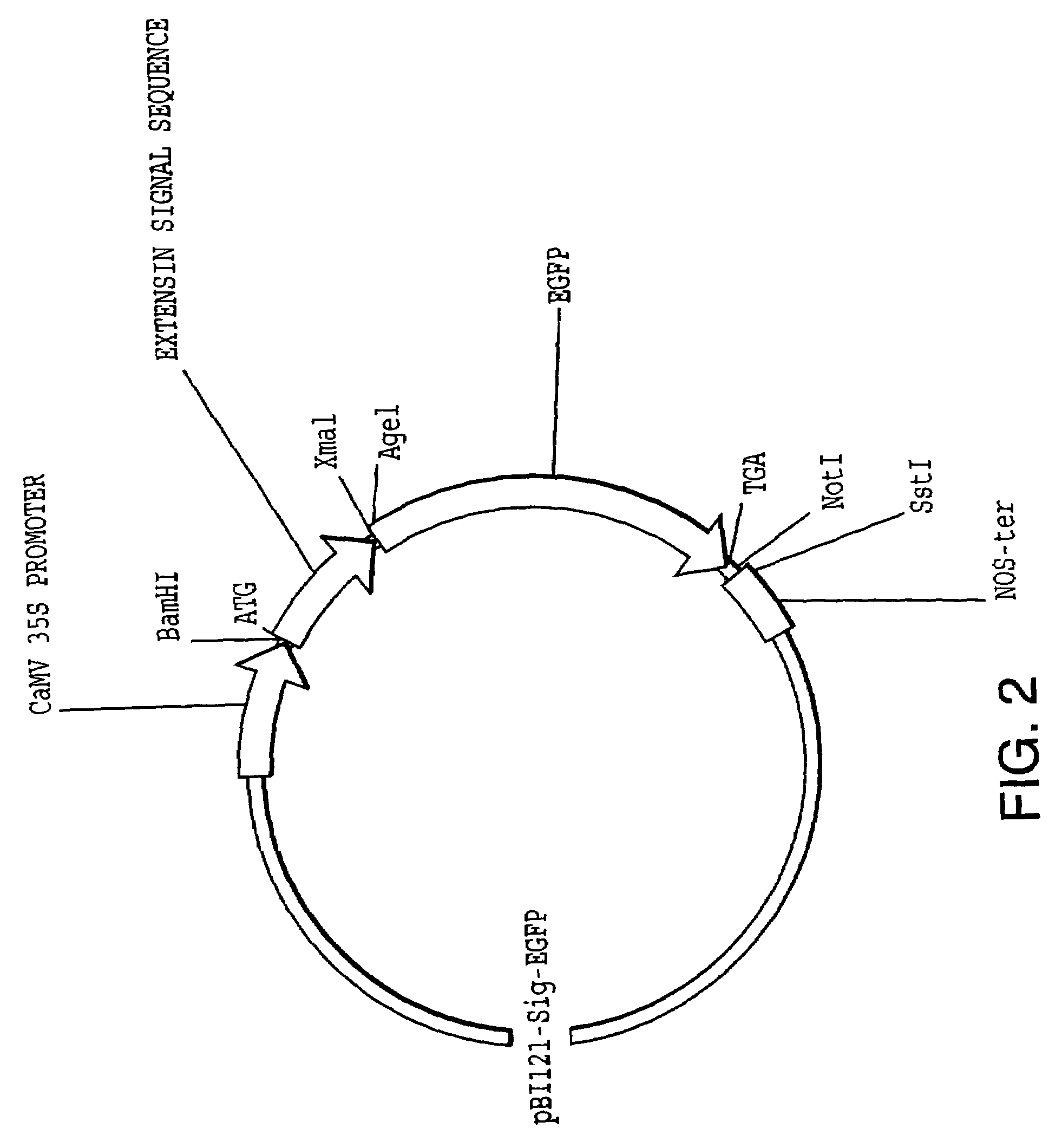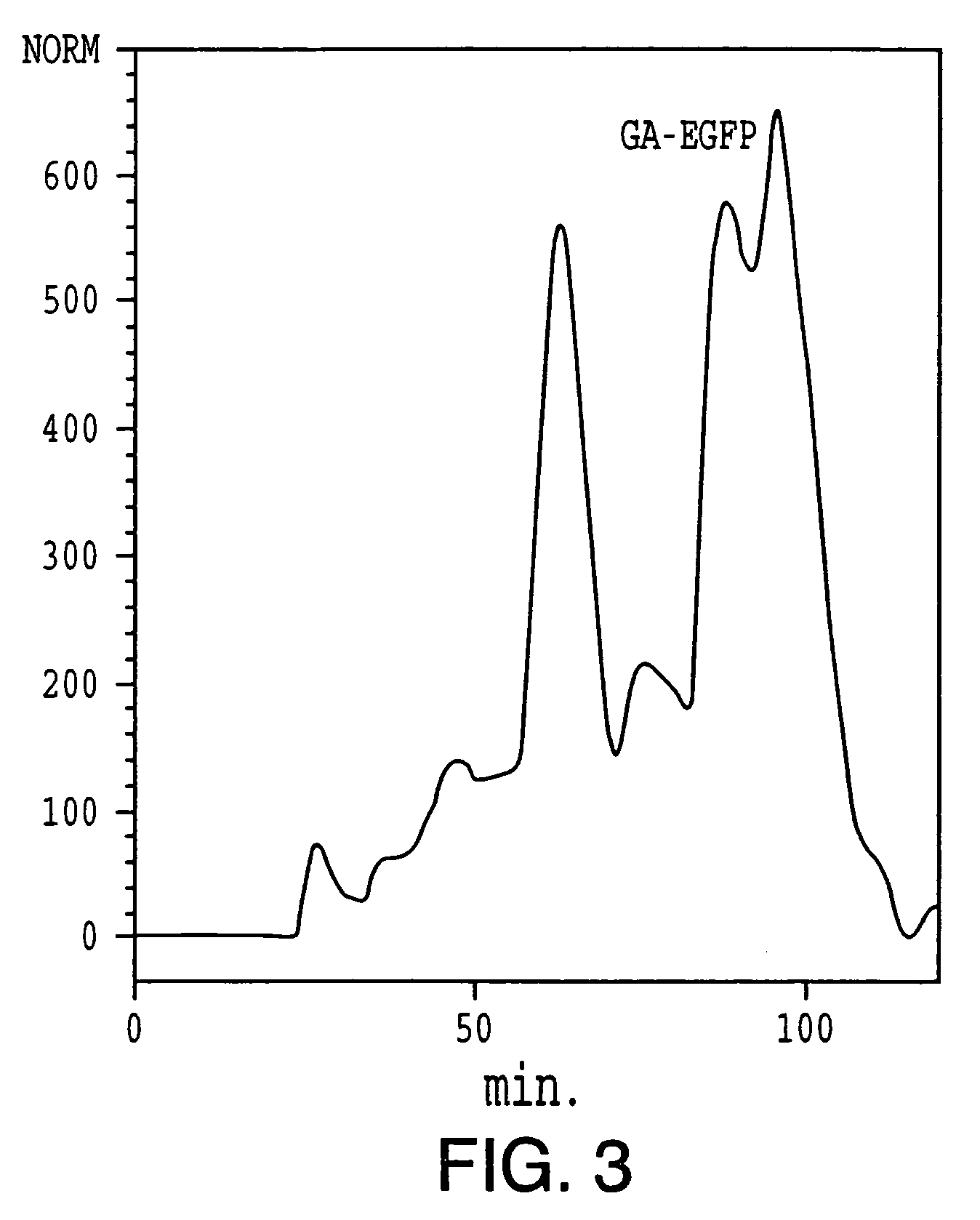Synthetic genes for plant gums and other hydroxyproline-rich glycoproteins
a technology of hydroxyproline and glycoprotein, which is applied in the direction of peptides, plant/algae/fungi/lichens ingredients, tissue culture, etc., can solve the problems of affecting the quality of plant gum, etc., and achieves the effect of being ready to be transformed
- Summary
- Abstract
- Description
- Claims
- Application Information
AI Technical Summary
Problems solved by technology
Method used
Image
Examples
example 2
Construction of Synthetic HRGP Gene Cassettes
[0256]Synthetic gene cassettes encoding contiguous and noncontiguous Hyp modules are constructed using partially overlapping sets consisting of oligonucleotide pairs, “internal repeat pairs” and “external 3′- and 5′-linker pairs” respectively, all with complementary “sticky” ends. The design strategy for the repetitive HRGP modules combines proven approaches described earlier for the production in E.coli of novel repetitive polypeptide polymers (McGrath et al. [1990] Biotechnol. Prog. 6:188), of a repetitious synthetic analog of the bioadhesive precursor protein of the mussel Mytilus edulis, of a repetitive spider silk protein (Lewis et al. [1996] Protein Express. Purif. 7:400), and of a highly repetitive elastin-like polymer in tobacco [Zhang, X., Urry, D. W., and Daniell, H. “Expression of an environmentally friendly synthetic protein-based polymer gene in transgenic tobacco plants,”Plant Cell Reports, 16: 174 (1996)].
[0257]The basic de...
example 3
Isolation of Tomato P1 Extensin cDNA Clones
[0276]In order to obtain the tomato P1 extensin signal sequence (i.e., signal peptide), P1 extensin cDNA clones were isolated using oligonucleotides designed after the P1-unique protein sequence (SEQ ID NO:51): Val-Lys-Pro-Tyr-His-Pro-Thr-Hyp-Val-Tyr-Lys. When present at the N-terminus of a protein sequence, the P1 extensin signal sequence directs the nascent peptide chain to the ER.
example 4
Construction of One Embodiment of an Expression Vector
[0277]pBI121 is an expression vector which permits the high level expression and secretion of inserted genes in plant cells (e.g., tomato, tobacco, members of the genus Solanaceae, members of the family Leguminoseae, non-graminaceous monocotyledons). pBI121 contains the 35S CaMV promoter, the tobacco (Nicotiana plumbaginifolia) extensin signal sequence, a EGFP gene, the termination / polyadenylation signal from the nopaline synthetase gene (NOS-ter), a kanamycin-resistance gene (nptII) and the right and left borders of T-DNA to permit transfer into plants by Agrobacterium-mediated transformation.
[0278]
TABLE 4ILLUSTRATIVE HRGP SYNTHETIC GENE MODULES1.MODULES FOR AGP-LIKE SEQUENCESa.The [SP]n Module[SP]n Internal Repeat Oligo's:5′-TCA CCC TCA CCA TCT CCT TCG(SEQ ID NO: 52)CCA TCA CCC GGT AGA GGA AGC(SEQ ID NO: 53)GGT AGT GGG AGT GGG AGT-5′The [SP]n 3′& 5′ External Linkers for both plas-mids are the same as for the GAGP ...
PUM
| Property | Measurement | Unit |
|---|---|---|
| Tm | aaaaa | aaaaa |
| optical density | aaaaa | aaaaa |
| degree of polymerization | aaaaa | aaaaa |
Abstract
Description
Claims
Application Information
 Login to View More
Login to View More - R&D
- Intellectual Property
- Life Sciences
- Materials
- Tech Scout
- Unparalleled Data Quality
- Higher Quality Content
- 60% Fewer Hallucinations
Browse by: Latest US Patents, China's latest patents, Technical Efficacy Thesaurus, Application Domain, Technology Topic, Popular Technical Reports.
© 2025 PatSnap. All rights reserved.Legal|Privacy policy|Modern Slavery Act Transparency Statement|Sitemap|About US| Contact US: help@patsnap.com



